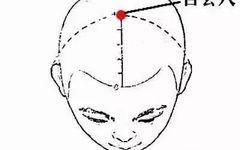Illness does not wait for anyone; health preservation should start early. Follow us to discuss health preservation together!
1. Baihui (Hundred Meetings) Point Promotes Qi and Blood Flow
First acupuncture point to address hair loss issues (hair loss, poor hair quality)
Method: Use a fist to tap the Baihui point rapidly and intermittently for about 5 minutes each time. Ensure the pressure is moderate. Alternatively, comb the scalp until it feels slightly warm, or use your fingers to comb the hair every morning and before bed.
Baihui point is located at the center of the top of the head, at the midpoint of the line connecting the tops of both ears.
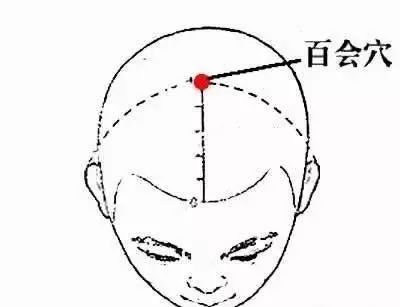
02. Dazhong (Great Bell) and Tianzhu (Heavenly Pillar) for Mental Clarity and Brain Health
For those feeling lethargic and lacking energy
Method: Massage Dazhong and Tianzhu points 30-50 times, or press and hold for 6 seconds and then slowly release. Repeat as needed.
Dazhong point is located on the inner side of the foot, 1 cm below the inner ankle, in the depression where the Achilles tendon attaches.
Tianzhu point is located at the depression just below the occipital bone. It is about 2 cm lateral to the midline at the base of the skull, where the trapezius muscle bulges.

03. Shuaigu (Leading Valley) Point for Migraines
(Migraines, Qi and Blood Stagnation Type. Symptoms: seeing stars, blurred vision, throbbing pain, possibly accompanied by nausea and irritability)
Method: Massage Shuaigu point every night at 11 PM for 10 minutes. It can also be done at any time. This not only treats migraines but also promotes sleep.
Shuaigu point is located 1.5 cun above the tip of the ear, directly opposite the ear tip.
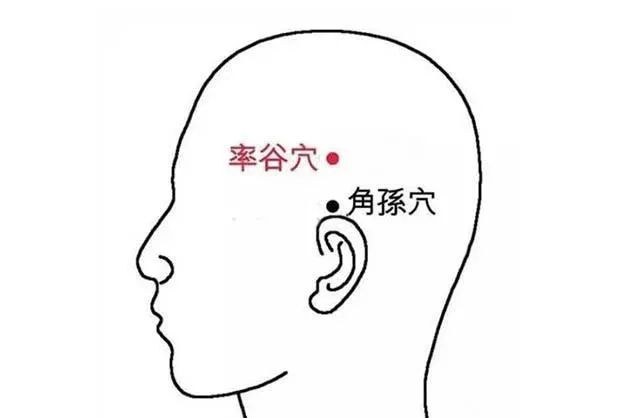
04. Jiexi (Relieving Stream) Point for Dizziness
(Dizziness due to Qi and Blood Deficiency; symptoms include dizziness upon standing, blackouts, restless sleep, vivid dreams, and forgetfulness)
Method: Press Jiexi point 10 times daily for 10 seconds each time, then release. Repeat for a month; also perform ankle rotation exercises.
Sit cross-legged on the bed, holding the ankles and soles of the feet, and rotate slowly; or sit on a chair with toes on the ground and rotate around the ankle. Do this for 100 times on each foot, morning and evening, for long-term health benefits.
Jiexi point is located at the intersection of the ankle and the foot, in the depression next to the hard tendon.
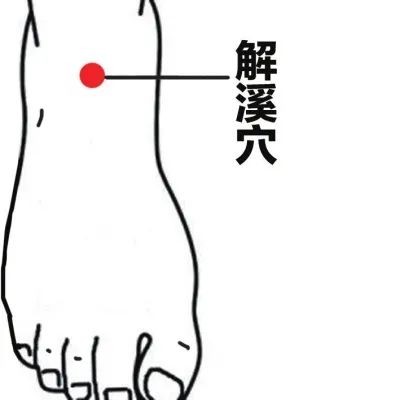
05. Shenting (Spirit Court) and Yintang (Hall of Impression) for Mental Fatigue
(For those who often use computers or engage in heavy mental labor)
Method: Use the index and middle fingers to push from Yintang to Shenting, then press both points for 3-5 minutes until a slight warmth is felt. This can be done at any time. Massaging these points before sleep can lead to deep, restful sleep and alleviate insomnia and vivid dreams.
Shenting point is located 0.5 cun above the midpoint of the hairline.
Yintang point is located at the midpoint of the line connecting the two eyebrows.
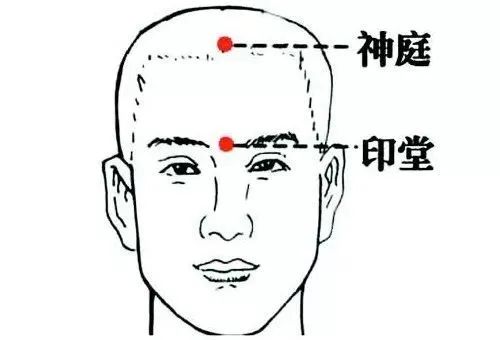
06. Dazhi (Great Mound) Point for Quick Blood Pressure Stabilization
(For those with high blood pressure due to irritability and liver Yang rising)
Method: Gently pinch Dazhi point with your fingernail or apply moxibustion for 10-15 minutes, and continue for more than half a month. This point has a calming effect and stabilizes emotions; if you have trouble sleeping, you can also massage it for 2-3 minutes.
Dazhi point is located about 0.1 cun beside the outer corner of the big toe nail.
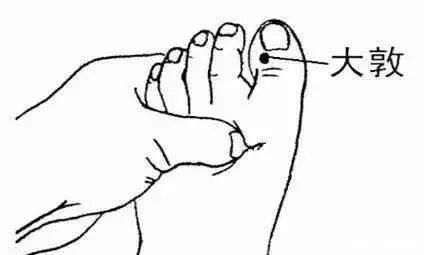
07. Tinghui (Listening Meeting) Point for Hearing Issues
(For hearing loss, tinnitus, toothache, facial nerve paralysis, and facial paralysis)
Method: Massage Tinghui point 350-400 times for about 15 minutes to see results.
Tinghui point is located at the anterior edge of the earlobe, at the posterior edge of the mandible, in the depression when the mouth is opened.
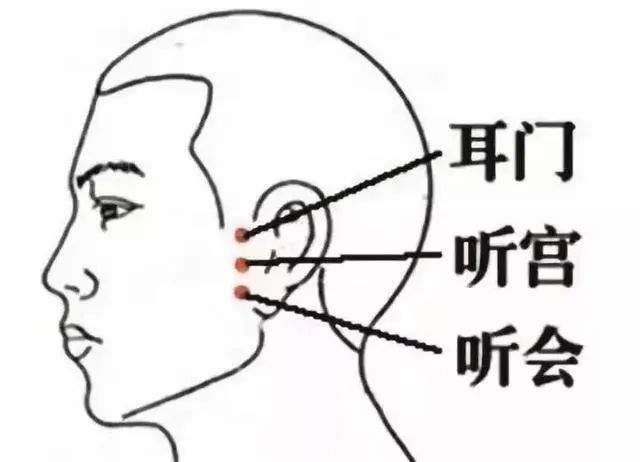
08. Houshu (Back Stream) Point for Eye Brightness
(For myopia)
Method: Use the thumb and index finger to massage Houshu point simultaneously for 5 minutes. Maintain this practice over the years. Alternatively, press the Houshu points against the edge of a table or keyboard and roll back and forth for 3-5 minutes each time, stimulating once every hour.
Houshu point is located at the end of the transverse crease of the hand, at the end of the emotional line.
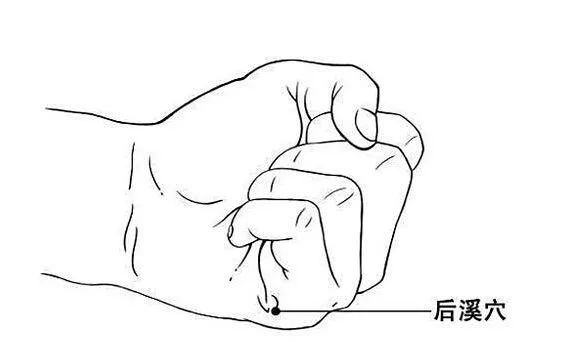
09. Tongziliao (Pupil’s Crevice) Point for Eye Health
(For tearing in the wind, liver Yin deficiency type)
Method: Massage Tongziliao point for 5-6 minutes, pressing 40 times each time. This treats tearing in the wind and can be combined with pressing Jingming point for better results.
Pressing Tongziliao point can also prevent the formation of crow’s feet.
Tongziliao point is located 1 cm lateral to the outer corner of the eye (where crow’s feet form).
Jingming point is located at the inner corner of the eye, at the junction of the nasal bridge and the inner eye corner.
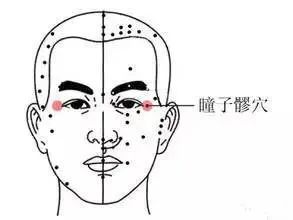
10. Jingming (Bright Eyes) Point for Eye Health
(For presbyopia)
Method: Use the thumb pads to press Jingming point vertically towards the deep part of the eye, pressing and releasing in a rhythm of four eights. Then use the backs of both thumbs to massage both sides of the Zanzhu point for 2 minutes, morning and evening, consistently over the years.
Another method: Use both middle fingers to massage the eyebrows 20 times; use all four fingers to massage the eyes outward 20 times; use both middle fingers to massage the nasal bridge upward 20 times; use both thumbs and index fingers to pull the earlobes downward 20 times.
Jingming point is located in the depression at the inner corner of the eye.
Zanzhu point is located at the inner side of the two eyebrows, where the eyebrows wrinkle.
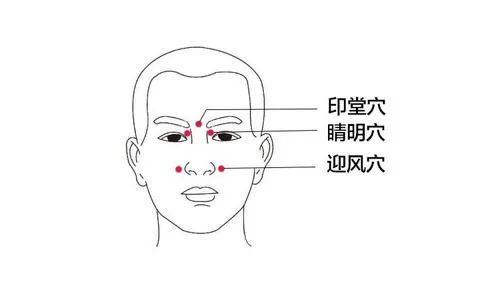
11. Sibai (Four Whites) Point for Dark Circles
(For liver and kidney deficiency, spleen and stomach weakness type)
Method: Use the second joint of the index finger to scrape the eye socket gently, twice a day, once before bed and once after waking, for at least 2 minutes each time. After scraping the eye socket, massage Sibai point for better results. Scraping the eye socket can stimulate Zanzhu, Yuyao, and Sizhukong points.
Sibai point is located about 2 cm below the center of the pupil.
This method can also help remove eye bags!
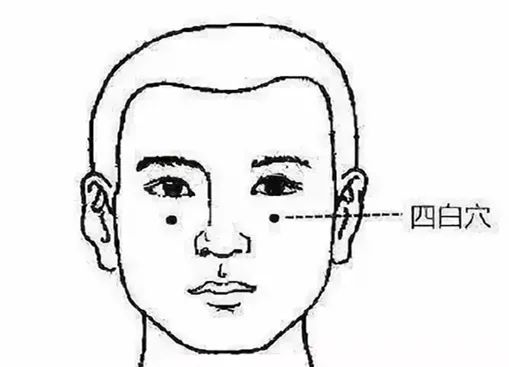
12. Yangxi (Yang Stream) Point for Eye Fatigue
(For visual fatigue, eye strain)
Method: Close your eyes and use the thumb of the opposite hand to press this point until a feeling of strain is felt, then relax. Repeat for 2-3 minutes at any time. You can also stick rice or mung beans on Yangxi point with tape and stimulate it frequently during free time.
Yangxi point is located on the dorsal side of the wrist, in the depression between the tendons of the thumb when it is extended.
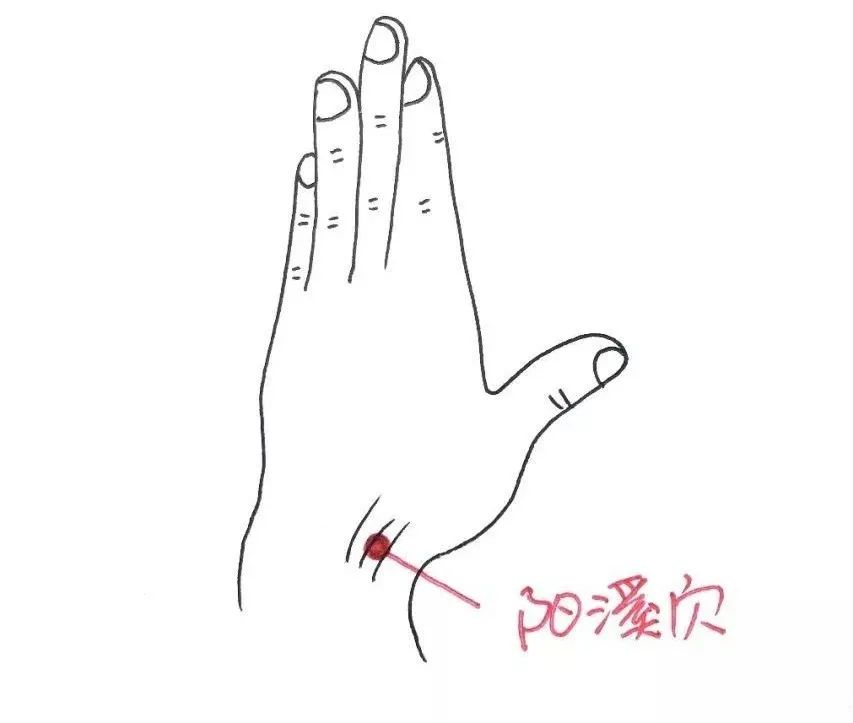
13. Yingxiang (Welcome Fragrance) Point for Rhinitis
(For allergic rhinitis, chronic rhinitis)
Method: Bend the thumb and use the joint to rub from the widest part of the nostril along the nasolabial groove up to the nasal bone, then return to the nostril. Repeat this massage 100 times or for 2 minutes. Consistent practice is recommended. Combining this with massages of Yintang, Bitong, and Hegu points will yield better results.
Yingxiang point is located directly below the center of the eyeball when looking straight ahead, in the nasolabial groove about half a thumb width from the nostrils; Yintang point is at the midpoint of the line connecting the two eyebrows; Bitong point is at the upper end of the nasolabial groove where the soft and hard tissues meet.
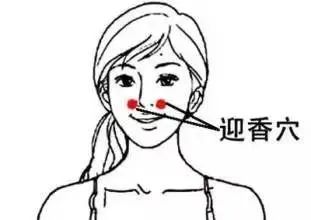
14. Renying (Human Welcome) Point for Double Chin
(For double chin)
Method: While exhaling, gently press Renying and Daying points for about 6 seconds each. Repeat Renying 10 times and Daying 30 times, or gently stroke down the neck with your hand, maintaining this practice over time.
Renying point is located 3 cm lateral to the Adam’s apple. Find your Adam’s apple, and you can feel the artery pulsing at this location.
Daying point is located at the side of the jawbone, below the lips.
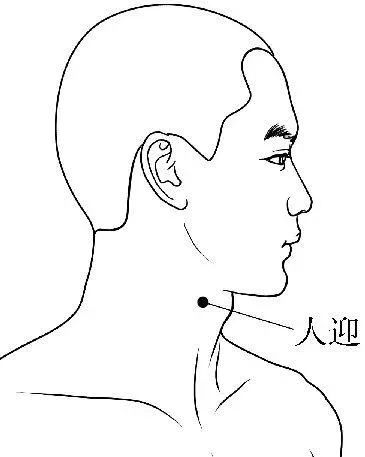
15. Zhizheng (Support Correct) Point for Skin Issues
(For acne and flat warts due to spleen deficiency and dampness)
Method: Massage Zhizheng point using kneading and pinching techniques, applying moderate pressure until a feeling of soreness is felt. Press about 100 times each time, maintaining this practice for half a month.
Flat warts are mainly caused by excessive dampness and spleen deficiency. After massaging Zhizheng point, combining it with massages of Fenglong point in the stomach meridian and Yinlingquan point in the spleen meridian will enhance the effect.
Zhizheng point is located on the back of the arm, 5 cun above the palm root, in the space between muscle and bone.
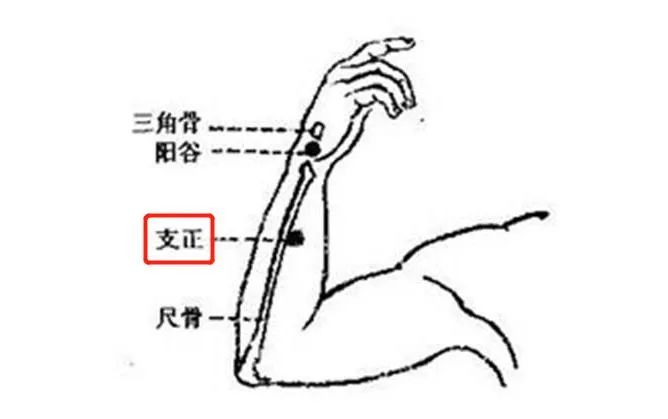
16. Quchi (Pool at the Bend) Point for Age Spots
(For age spots)
Method: Massage Quchi point at any time.
This point can drain large intestine fire, clear heat, dispel wind, and cool blood. It helps detoxify, purify the intestines, and beautify the skin.
Quchi point is located at the outer end of the elbow crease, at the midpoint of the line connecting the ulnar notch and the outer condyle of the humerus.
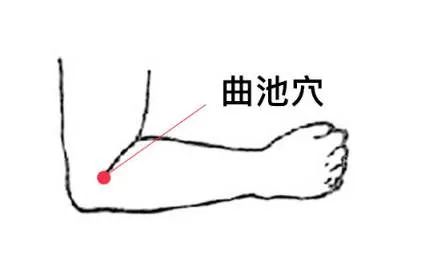
17. Wenliu (Warm Flow) Point for Acne
(For acne and cold hands and feet)
Method: Press Wenliu point firmly with the thumb until a feeling of strain is felt, massaging for 2-3 minutes, or apply moxibustion for 10-15 minutes. Do this once daily for long-term benefits.
Wenliu point is located 5 cun above the wrist crease, on the line connecting Yangxi and Quchi points.
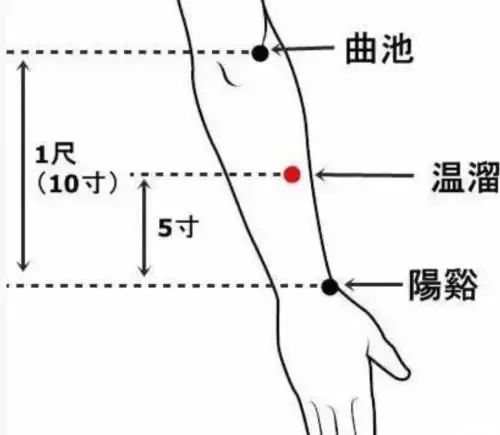
18. Daling (Great Tomb) Point for Stomach Fire
(For acid reflux, bloating, and poor digestion)
Method: Press Daling point firmly with the thumb until a feeling of strain is felt, massaging for at least 3 minutes at any time.
Daling point is located at the midpoint of the wrist crease.
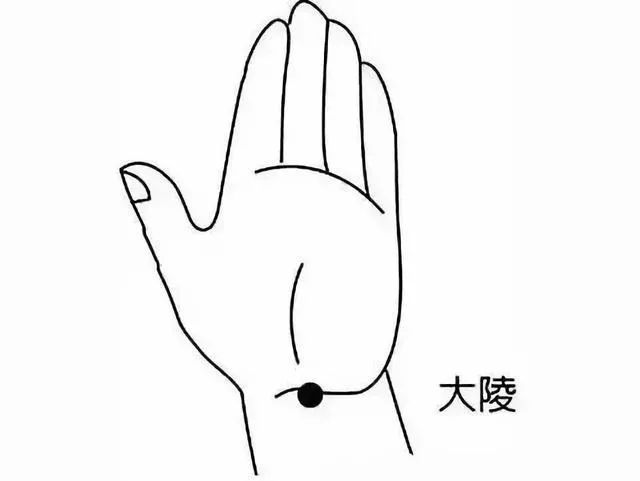
19. Yanggu (Yang Valley) Point for Oral Ulcers
(For oral ulcers, heart fire type)
Method: Gently stimulate Yanggu point with the thumb, massaging for 3 minutes, 3-4 times a day.
Oral ulcers are mainly caused by excessive heart fire, heat accumulation in the spleen and stomach, Yin deficiency fire, and cold in the liver affecting the stomach. Additionally, physical weakness and overconsumption of rich foods can lead to spleen dysfunction and liver Qi stagnation.
Yanggu point is located between the ulnar styloid process and the triangular bone on the ulnar side of the wrist.
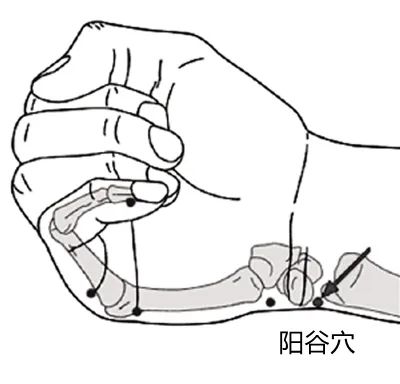
20. Tongli (Passage to the Heart) Point for Temporary Aphasia
(For aphasia)
Method: Massage Tongli and Lingdao points for 2-3 minutes each.
Aphasia is mainly caused by Qi deficiency, blood stasis, wind, fire, and phlegm obstructing the liver Yang, leading to insufficient nourishment of the brain, emotional agitation, and impaired cerebral circulation, resulting in confusion and aphasia.
Tongli point is located 1 cun above the wrist crease.
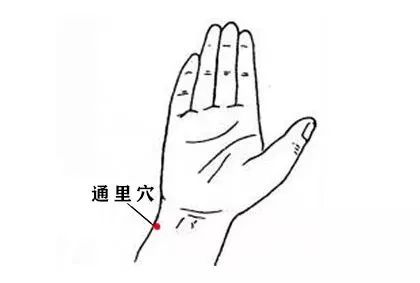
21. Shizai (Elbow) Point for Sore Throat
(For sore throat and chronic pharyngitis)
Method: Alternate massage Shizai and Upper Shizai points. Press Shizai point for 6 seconds, then press Upper Shizai point for 6 seconds, repeating this 10 times, twice daily.
Shizai point is located at the elbow crease, on the outer side of the forearm.
Upper Shizai point is located 3-4 cm above Shizai point.
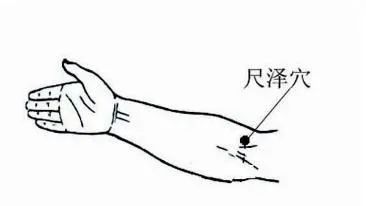
22. Waiguan (Outer Pass) Point for Liver Qi Stagnation
(For plum pit Qi)
Method: Press and massage Waiguan point for 10 minutes during an episode.
Waiguan point is located on the dorsal side of the forearm, 2 cun above the wrist crease, on the line connecting Yangchi and the elbow tip.
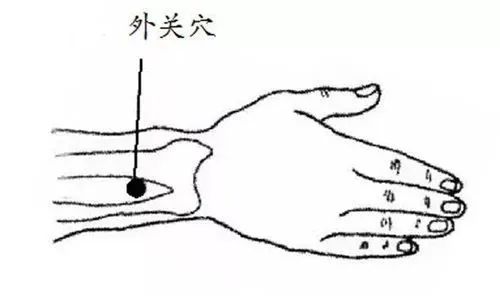
23. Qiangu (Front Valley) Point for Tonsillitis
(For tonsillitis and sore throat)
Method: Massage Qiangu point for about 10 minutes.
Qiangu point is located at the outer end of the third joint of the little finger.

24. Xuanzhong (Suspended Bell) Point for Cervical Spondylosis
(For cervical spondylosis)
Method: Use the thumb to massage Xuanzhong point, while the other four fingers hold the calf, massaging three times a day for 15 minutes each time. Symptoms will disappear after a week. Regularly perform the “Yong” character exercise.
Xuanzhong point is located 3 cun above the outer ankle tip, 1 cun behind the fibula.
Yong character exercise method: Stand upright with feet shoulder-width apart, using the neck as the wrist and the head as the pen, write the Yong character in standard script. Count each character written as one repetition, doing 20-30 repetitions each time (gradually increasing the number). While in this standing position, also perform shoulder shrugging exercises, doing 30 repetitions each time or frequently patting the neck muscles while moving the cervical spine. Long-term adherence can improve blood circulation to the head, relax muscles, nourish bones, and promote meridian flow, which is beneficial for preventing and treating cervical spondylosis.
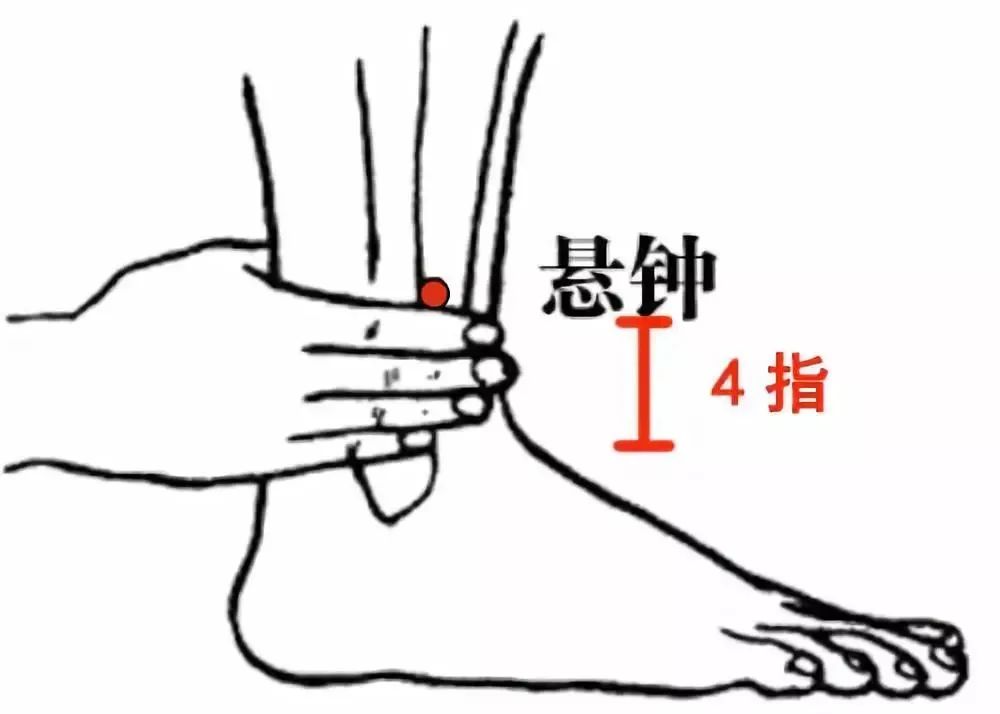
25. Tianjing (Heavenly Well) Point for Neck Swelling
(For lymphadenitis, liver Qi stagnation type)
Method: Gently massage Tianjing point, and you will see results in a week.
Lymphadenitis can be classified into several types, including liver Qi stagnation, lung and kidney Yin deficiency, lung and kidney Yang deficiency, and Qi and blood deficiency, all of which are closely related to the “Qi” that regulates the body.
Tianjing point is located on the outer side of the arm, 1 cun directly above the elbow tip.
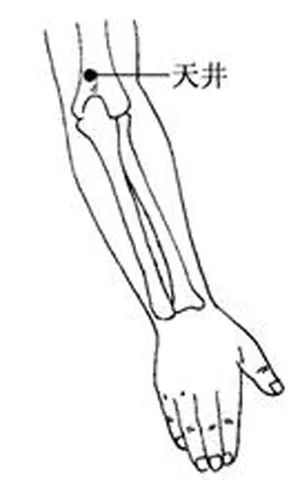
26. Lingdao (Spirit Path) Point for Chest Pain
(For chest pain, non-congenital heart disease without organic damage)
Method: Massage Lingdao point three times a day for 3 minutes each time. Long-term adherence is recommended. There is a line under the palm, and Lingdao point is located 1.5 cun below this line.
Lingdao point is specifically for treating heart conditions and can help ensure smooth Qi and blood flow to the heart.
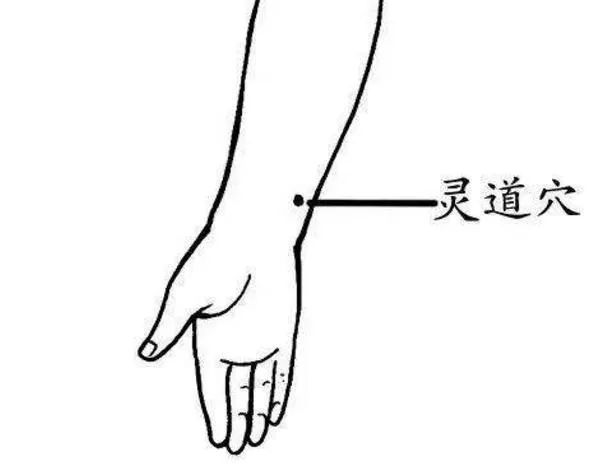
27. Shaohai (Lesser Sea) Point for Insomnia
(For insomnia, heart and kidney disharmony type)
Method: Massage Shaohai point at any time.
Heart and kidney disharmony refers to heart Yang deficiency, where heart fire cannot descend to warm the kidney, or kidney Yin deficiency, where kidney water cannot ascend to nourish the heart, leading to symptoms such as night sweats, irritability, excessive sweating, insomnia, and vivid dreams. The Gu point also treats insomnia, particularly for those with Yin deficiency and excessive fire.
Shaohai point is located at the inner end of the elbow crease, at the midpoint of the line connecting the inner condyle of the humerus.
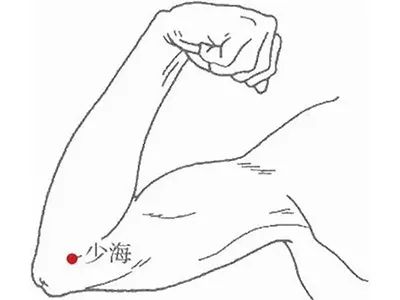
28. Yinxu (Yin Cleft) Point for Night Sweats
(For middle-aged and elderly night sweats)
Method: Massage both sides of Yinxu point for 5 minutes each with moderate pressure, and you will see results in half a month.
Yinxu point is located on the palmar side of the forearm, at the ulnar side of the wrist flexor tendon, 0.5 cun above the wrist crease. It has nourishing Yin and blood effects.
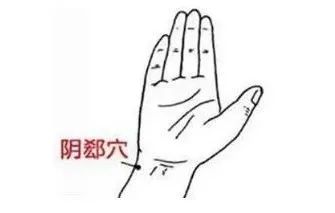
29. Qiemen (Gate of Qi) Point for Chest Pain
(For chest pain)
Method: Press Qiemen point firmly for 3-5 seconds, pause for 1-2 seconds, then continue pressing for 2-3 minutes, or press firmly while rotating the arm inward and outward for about 2 minutes to relieve pain quickly.
Qiemen point is located on the palmar side of the forearm, 5 cun above the wrist crease, on the line connecting Quze and Daling points. This point is the best and fastest pain relief remedy and has a good effect on blood circulation. It is located on the hand’s pericardium meridian.
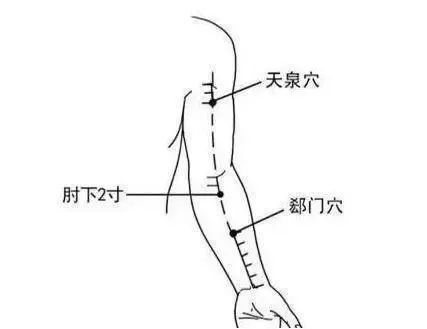
30. Neiguan (Inner Pass) Point for Heart Health
(For preventing and treating cardiovascular diseases)
Method: Firmly press Neiguan point for 2-3 minutes until a feeling of soreness, numbness, or swelling is felt, or stick a grain of rice on Neiguan point with tape and press it occasionally during free time.
Note: It is best to massage the pericardium meridian between 7-9 PM, half an hour after meals.
Neiguan point is located on the palmar side of the forearm, about 2 finger widths above the wrist crease, between the two prominent tendons. Make a fist and bend the wrist, and the point is located 2 finger widths down from the transverse crease, between the two tendons.
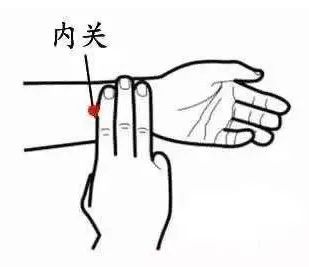
31. Jiquan (Extreme Spring) Point for Heart Support
(For chest tightness, palpitations, and shortness of breath in middle-aged and elderly individuals)
Method: Daily press Jiquan point until the fingers and arms feel numb.
Jiquan point is located in the armpit, where a large tendon is found. Pressing it will cause the ring and little fingers to feel numb, indicating the location of Jiquan point.
Qi is the commander of blood, and blood is the mother of Qi. When Qi stagnates, blood stagnates; when Qi flows, blood flows. Pressing Jiquan point promotes Qi and blood circulation. After pressing, gently tap down the arm along the midline to relieve chest tightness and facilitate smooth breathing, while also resolving internal stagnation.
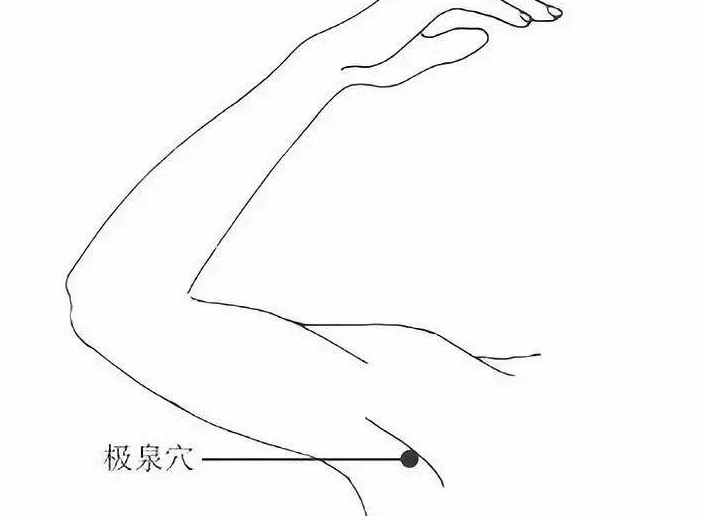
32. Zhongfu (Central Palace) and Yunmen (Cloud Gate) Points for Cough and Asthma
(For cough and asthma)
Method: Massage Zhongfu and Yunmen points with slight pressure in a circular motion for 1-2 minutes, maintaining this practice over time.
Zhongfu point is located 1 cun below Yunmen point, 6 cun from the midline, at the level of the first intercostal space.
Yunmen point is located in the supraclavicular fossa. Both points are on the lung meridian.
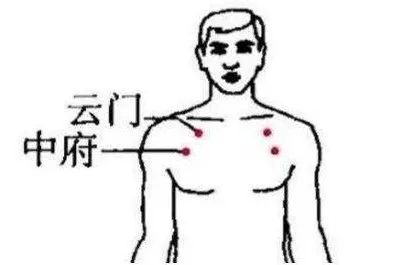
33. Taiyuan (Great Abyss) Point for Throat Pain
(For difficulty breathing, throat pain, and hoarseness)
Method: Gently press Taiyuan point with the thumb while supporting the wrist with the other four fingers, massaging for 3-5 minutes. You can also use crushed goji berries, apply them to Taiyuan point, and secure with medical tape before sleeping. Remove in the morning to help alleviate Qi deficiency.
Taiyuan point is located on the transverse crease of the wrist at the base of the thumb. When the palm is extended, a large tendon will rise, and the point is located in the depression on the inner side of this tendon, where a pulse can be felt.
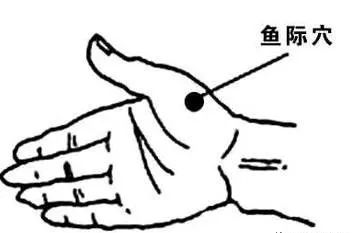
34. Yinlingquan (Yin Mound Spring) Point for Cough with Phlegm
(For cough with phlegm and black nasal discharge due to spleen deficiency and dampness)
Method: Firmly press Yinlingquan point with the thumb, or gently tap with a small health hammer, stimulating for at least 3 minutes, three times a day, or apply moxibustion for 3-7 minutes once daily.
Yinlingquan point is located on the inner side of the lower leg, below the medial condyle of the tibia, in the depression.
The main causes of excessive phlegm include cold, wind, heat, dampness, or dryness invading the lungs. The spleen is responsible for managing dampness and is crucial for transformation and transportation.
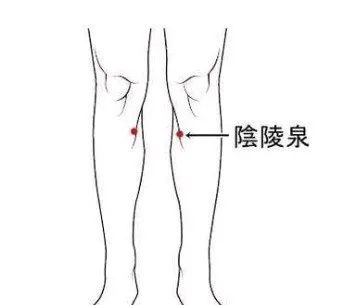
35. Yujie (Fish Ridge) Point for Children’s Health
(For preventing and treating children’s colds and digestive issues)
Method: One hand remains still while the other hand vigorously rubs the Yujie point on the opposite palm about 10 times until the entire palm feels warm. Then switch hands and rub the other hand.
Massaging Yujie can be done by pushing or kneading. The direction of the push affects the outcome. Pushing from the base of the thumb towards the wrist crease is effective for treating diarrhea in children. Pushing from the wrist crease towards the base of the thumb can help stop vomiting. Alternating pushes can effectively regulate children’s spleen and stomach functions. The rubbing time should be between 2-3 minutes, and pushing should be done at least 50-100 times.
Yujie point is located in the depression behind the first metacarpophalangeal joint of the thumb, at the junction of the red and white flesh.
Yujie also has functions of relieving exterior symptoms, benefiting the throat, and resolving phlegm, showing significant efficacy for symptoms like sore throat, cough, and sneezing caused by colds.

36. Zhigou (Branch Ditch) Point for Qi Stagnation
(For chest tightness and Qi stagnation)
Method: Massage Zhigou point for 5 minutes, then rub along the ribs for 3 minutes.
Zhigou point is located on the dorsal side of the forearm, 3 cun above the wrist crease, on the line connecting Yangchi and the elbow tip.
This point acts as the body’s “vent”, and regular massage can relieve unspoken pain and make the body feel lighter.
It belongs to the Sanjiao meridian, which governs the Qi of the entire body.
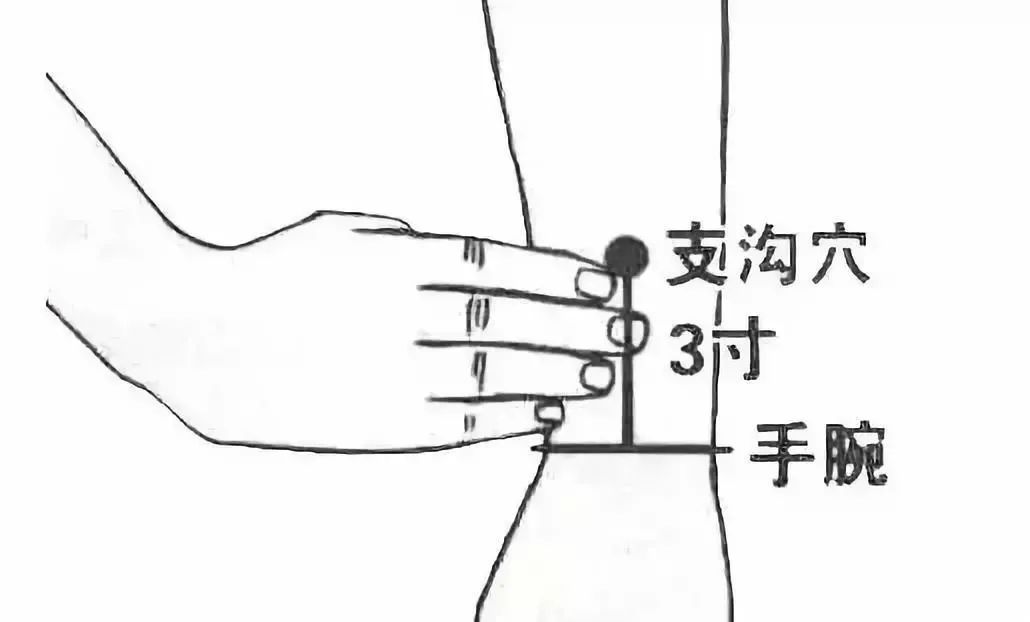
37. Rangu (Burning Valley) Point for Diabetes
(For diabetic patients)
Method: Firmly press both sides of Rangu point until a feeling of strain is felt, then release, and repeat 10-20 times until the feeling of strain does not go away. Long-term adherence is recommended for auxiliary treatment. This point belongs to the kidney meridian, which is associated with water.
For children with poor appetite, mothers can massage for a period to see improvement.
Rangu point is located on the inner edge of the foot, below the tuberosity of the navicular bone, at the junction of the red and white flesh.
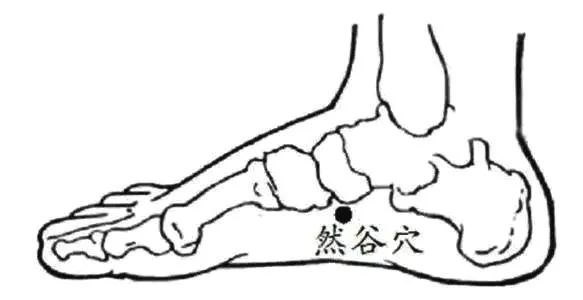
38. Taichong (Great Surge) Point for Fatty Liver
(For middle-aged and elderly individuals with fatty liver)
Method: Soak your feet in warm water for 10-15 minutes, then use the thumb pads to press Taichong point firmly for 30 seconds, pausing briefly, until a feeling of strain is felt. Repeat this for a total of 3 minutes. You can also press along the bone seams and slide back and forth, repeating this 20 times. Long-term adherence is recommended.
Taichong point belongs to the liver meridian. It has dual functions of tonifying deficiency and draining excess, promoting blood circulation, invigorating liver Qi and blood, clearing the liver and gallbladder, and calming the liver Yang, thus having a tonifying effect on the liver. Regular stimulation can also improve sleep. The treatment for fatty liver should focus on soothing the liver, regulating Qi, and promoting blood circulation.
Taichong point is located on the dorsum of the foot, in the depression between the first and second metatarsal bones, 3 finger widths back.
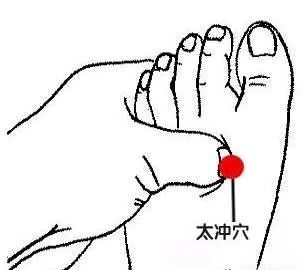
If you find this helpful, please like and share it with your friends!▼

